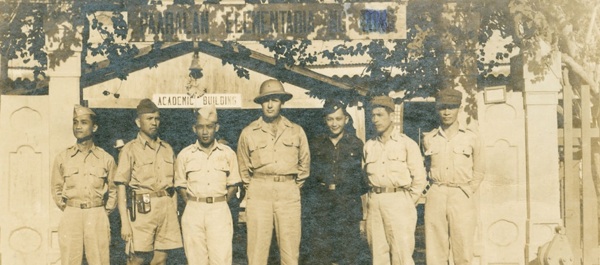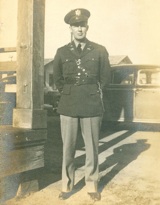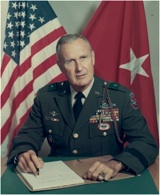Donald D. Blackburn: Guerrilla Leader and Special Forces Hero

The fires on Bataan burned with a primitive fury on the evening of April 9, 1942, illuminating the white flags of surrender against the nighttime sky. Woefully outnumbered, outgunned, and ill-equipped, the battered remnants of the American-Philippine army surrendered to the wrath of the Rising Sun. Yet amongst the chaos and devastation of the American defeat, Army Captain Donald D. Blackburn refused to lay down his arms.
Together with Russell Volckmann, the pair escaped into the mountainous jungles of North Luzon, where they raised a private army of over 22,000 men against the Japanese. Under Volckmann’s leadership, Blackburn raised a guerrilla regiment from among the native tribes in the Cagayan Valley. “Blackburn’s Headhunters,” as they came to be known, devastated the Japanese within the eastern provinces of North Luzon and captured the enemy-held seaport of Aparri.
{default}After the war, Blackburn remained on active duty and played a key role in initiating Special Forces operations in Southeast Asia. In 1959, as commander of the 77th Special Forces Group, Blackburn spearheaded Operation White Star in Laos. (White Star, July 1959–October 1962, involved the use of U.S. Army Special Forces to support the Royal Laotian government in operations against the Pathet Lao communist insurgency in that country.–Ed.) Six years later, at the outset of America’s combat mission in Vietnam, Blackburn took command of the highly classified Studies and Observation Group (SOG).
In the wake of the CIA’s disastrous Leaping Lena program (Air drops of South Vietnamese intelligence-gathering teams along the Ho Chi Mihn Trail, virtually all of whom were captured or killed.—Ed.), Blackburn revitalized the special operations campaign in South Vietnam. Sending cross-border reconnaissance teams into Laos, Blackburn discovered the clandestine networks and supply nodes of the infamous Ho Chi Minh Trail. Taking this information directly to General William C. Westmoreland, Blackburn received authorization to destroy and interdict any traffic coming down along the Trail. Upon his return to the United States, Blackburn was appointed the “Special Assistant for Counterinsurgency and Special Activities” (SACSA) and became the architect of the Son Tay Prison Raid—the largest POW rescue mission of the Vietnam War.
* * *
Blackburn’s story begins on the idyllic shores of the American Sunbelt. Born on September 14, 1916, in West Palm Beach, Florida, “Don” spent his formative years growing up in the suburbs of Tampa. From an early age, the young Blackburn held a remarkable fascination for all things military. Graduating from Park High School in 1934, he quickly enrolled in the Army ROTC program at the University of Florida. Four years later, Don graduated with a commission as a Second Lieutenant of Infantry. After two years in the Army Reserve, Blackburn entered active duty on September 22, 1940.
 His initial orders assigned him to Fort Benning where he served as a Battalion Signal Officer in the 24th Infantry Regiment. After spending less than a year at Fort Benning, however, Blackburn was unwillingly transferred to the Philippine Islands. A US commonwealth since 1898, by 1940, the Philippines had begun their transition to full sovereignty. And, as part of the independence deal, the US agreed to help the Filipinos establish their own military. To this end, the US Army sent hundreds of its young officers to serve as advisors and low-level commanders in the newly budding Philippine Army.
His initial orders assigned him to Fort Benning where he served as a Battalion Signal Officer in the 24th Infantry Regiment. After spending less than a year at Fort Benning, however, Blackburn was unwillingly transferred to the Philippine Islands. A US commonwealth since 1898, by 1940, the Philippines had begun their transition to full sovereignty. And, as part of the independence deal, the US agreed to help the Filipinos establish their own military. To this end, the US Army sent hundreds of its young officers to serve as advisors and low-level commanders in the newly budding Philippine Army.
Arriving in the Philippines in October 1941, Blackburn assumed his role as an advisor to the 12th Infantry Regiment, 11th Division (Philippine Army). He soon discovered, however, that the Philippine Army was an army that existed only on paper. His soldiers were equipped with outdated rifles that hadn’t been fired since World War I, and they had virtually no knowledge of military tactics. To make matters, nearly three-quarters of his men couldn’t speak English. Undaunted, Blackburn spent the next six weeks training his ill-equipped Filipinos in the art of American soldiering. However, on December 8, 1941, Blackburn had to take these ill-prepared troops into combat.
Shortly after their surprise attack on Pearl Harbor, the Empire of Japan began its invasion of the Philippine Islands. Over the next five months, Blackburn and his comrades intermittently traded fire with the Imperial Japanese Army while retreating to the Bataan Peninsula. Arriving in Bataan, Blackburn was re-assigned to the 11th Division Headquarters Staff, where he became well-acquainted with Major Russell Volckmann. Volckmann had commanded a Philippine Army regiment during the retreat and now, like Blackburn, found himself unwittingly cast into a Division Staff position. Meanwhile, the situation on Bataan continued to deteriorate and on April 9, 1942, American forces surrendered to the Rising Sun. To Blackburn and Volckmann, however, “surrender” was unacceptable.
Fortunately, days prior to the surrender, Volckmann found a glimmer of hope within a few intelligence reports he had gathered from the Division Command Post. According to these reports, there were a few Philippine Army regiments that had been caught behind enemy lines in the Mountain Province of North Luzon. Some of these regiments continued to harass the Japanese’s rear echelons while others had simply dissolved into the wilderness. Since Mountain Province was a purported hotbed of American support, Volckmann and Blackburn thought it would be an ideal place to start a resistance movement. It was a bold idea, but they were convinced that it was better to take their chances in the wilderness than to surrender to the Japanese.
As the enemy closed in on their Division Headquarters, Blackburn and Volckmann narrowly escaped into the jungles of Bataan. Spanning nearly six months, their journey was fraught with disease, starvation, and near-misses with Japanese spies and foot patrols. When he reached Mountain Province, however, Blackburn found that several members of the Philippine Army, Philippine Scouts, and Philippine Constabulary had indeed remained in the area. (The Philippine Scouts were an American Army unit in which all enlisted soldiers and most of the junior officers were Filipino. The Philippine Constabulary was the nation’s paramilitary police force.) Under Volckmann’s leadership, he organized these displaced veterans into five regiments and brought them under one command: a guerrilla force which Volckmann named The United States Armed Forces in the Philippines – North Luzon (USAFIP-NL).
Volckmann assigned each regiment its own “military district.” Blackburn assumed command of Fourth District, encompassing the Cagayan River valley and the eastern provinces of North Luzon. Here he discovered that, aside from the numerous Philippine Scouts and Philippine Army soldiers, several native tribesmen were eager to volunteer as well. Training these native guerrillas in rifle marksmanship and small unit tactics, his regiment soon earned the nickname “Blackburn’s Headhunters.”
With a regiment of nearly 5,000 guerrillas at his back, Don Blackburn began a campaign that systematically destroyed the Japanese 14th Army within the Cagayan Valley. He started by eliminating Japanese spies in the towns along the Cagayan River. With the enemy’s “fifth column” neutralized, Blackburn soon began organizing raids on Japanese garrisons, supply depots, and fuel dumps. His campaign along the Cagayan Valley received an even greater boost with the arrival of the Sixth US Army. A composite unit known as Task Force Baker (consisting of elements from the 6th Ranger Battalion and the 510th Engineers) rendezvoused with Blackburn’s men in June 1945 and together the two forces cleared the Japanese from Aparri, the largest enemy-held seaport.
Near the conclusion of Blackburn’s Cagayan Valley campaign, the Sixth Army transferred its authority over Luzon to the Eighth Army—and Blackburn’s Headhunters received another mission. By late summer 1945, the Japanese in North Luzon had been defeated at every turn. Desperate to make a last stand, a small Japanese force under Generals Kizo Mikami and Yutaka Marauka built a defensive perimeter around the town of Mayayao. The XIV Corps (a subordinate corps of the Eighth Army) feared that the Mayayao contingent would disrupt the US 6th Division’s supply lines and instructed Blackburn to eliminate the Japanese at Mayayao.
From July 15 until August 9, 1945, under the cover of mortar attacks and P-38 air strikes, Blackburn’s men stormed the Japanese redoubts and systematically pacified their defenses. A few days later, Blackburn received the greatest news he had heard in four years: Japan had surrendered; the war was over. When General Mikami’s Chief of Staff approached Blackburn’s Headquarters to discuss the terms of surrender, the chief of staff pulled out a map of the Japanese disposition in the Cagayan Valley. Featured prominently on the map was a red circle drawn around the location of Blackburn’s Headquarters. But to Blackburn, this didn’t make sense. If the Japanese knew where he was, why didn’t they just attack his headquarters? Mikami’s Chief of Staff simply replied, “Too many guerrillas.” By the Japanese’s estimate, Blackburn must have had at least 10,000 guerrillas under his command. Blackburn looked up from the map and said, “I never had more than two battalions (about 3,000 men total) at one time.” The Japanese officer was speechless.
* * *
After the war, Blackburn remained on active duty and played a key role in initiating Special Forces operations in Southeast Asia. In 1957, he was assigned to the Military Assistance Advisory Group (MAAG), Vietnam, as the Senior Advisor to the 5th Military Region (Mekong Delta). During his yearlong advisory tour, Blackburn noticed that the South Vietnamese Army (ARVN) had no standardized training curricula and no viable strategy to deal with the Viet Cong. Taking these observations to heart, Blackburn eventually devised a four-week training program based on the US Army Ranger model. With training centers at Da Nang, Song Mao, and Nha Trang, the ARVN Rangers had the best reputation of any indigenous troops operating in South Vietnam.
 In 1959, after Blackburn assumed command of the 77th Special Forces Group at Fort Bragg, North Carolina, he spearheaded Operation White Star in Laos—the first major deployment of Special Forces to a country with an active insurgency. At the request of the Laotian monarchy, the 77th trained the Royal Laotian Army in their struggle against the Communist Pathet Lao. White Star continued until the declaration of Laotian neutrality in 1962.
In 1959, after Blackburn assumed command of the 77th Special Forces Group at Fort Bragg, North Carolina, he spearheaded Operation White Star in Laos—the first major deployment of Special Forces to a country with an active insurgency. At the request of the Laotian monarchy, the 77th trained the Royal Laotian Army in their struggle against the Communist Pathet Lao. White Star continued until the declaration of Laotian neutrality in 1962.
After relinquishing command of the 77th, Blackburn returned to Vietnam in 1965 as commander of the Studies and Observations Group (SOG), a highly-classified special operations group created in early 1964. When Blackburn assumed command of SOG the following year, the biggest problem facing US forces was the Communist infiltration from the north. Sending cross-border reconnaissance teams into Laos, Blackburn identified the vast networks and supply nodes of the Ho Chi Minh Trail. Taking this information to General Westmoreland, Blackburn received authorization to intercept and destroy all enemy traffic along the Laotian border. From these beginnings in 1965–66, SOG’s cross-border campaign soon expanded into Cambodia and North Vietnam. By the end of the war, SOG achieved a remarkable 150:1 kill-to-loss ratio and destroyed or captured over 1,000 tons of enemy equipment moving along the Ho Chi Minh Trail.
In early 1969, Blackburn prepared himself for what would be the culminating position of his career. Reporting to the Chairman of the Joint Chiefs, Blackburn was appointed the Special Assistant for Counterinsurgency and Special Activities (SACSA). Essentially a “Special Operations Czar,” SACSA was an office that had been set up during the Kennedy years. Most of its activities, Blackburn said, “were devoted to limited war and counterinsurgency, particularly as they related to Vietnam.” On May 25, 1970, “an Air Force briefing team came to me,” he said, “and asked if SACSA could set up a rescue mission using US Army Special Forces Personnel” to rescue a number of POWs at the Son Tay Prison Camp in North Vietnam. Forwarding this proposal to General Earl Wheeler, then-Chairman of the Joint Chiefs, Blackburn said that he could organize a rescue mission using only a handful of helicopters and a few Special Forces teams. According to Blackburn, the North Vietnamese had played by their own rules for too long—ignoring the Geneva Convention and repeatedly violating their neighbors’ neutrality. The time had come to strike the North Vietnamese in their own backyard.
The Joint Chiefs approved Blackburn’s plan and the Son Tay rescue mission went forward. From September 9 until November 10, 1970, the Son Tay raiders trained under the utmost secrecy. They were permitted no contact with the outside world and were not even told of their destination until they arrived in Southeast Asia. With fifty-six SF personnel aboard six Air Force helicopters, the Son Tay Prison Raid launched from Udorn Royal Air Base in Thailand on November 18, 1970. The raiders landed at Son Tay as scheduled, but discovered that there were no POWs at the camp. There were, however, plenty of NVA. Dazed and confused by the American intrusion, the North Vietnamese tried to rally a counteroffensive, but to no avail. Indeed, before the enemy even knew what was happening, the American raiders had already killed thirty of them. A mere twenty-seven minutes after their insertion, the Son Tay raiders were extracted by their helicopters. No POWs had been rescued, but not a single American life had been lost during the operation.
 Upon their return to the United States, the raiders’ mission was deemed a “tactical success” but overshadowed by what many called an “intelligence failure”: the POWs had been relocated to another camp fifteen miles away four months earlier, on July 14, 1970. Opponents of the Vietnam War denounced the Son Tay raid and feared that the treatment of American POWs would get worse. In fact, just the opposite happened. Hanoi suddenly realized that their country was not invulnerable to American ground troops and, as a result, the treatment of American POWs vastly improved.
Upon their return to the United States, the raiders’ mission was deemed a “tactical success” but overshadowed by what many called an “intelligence failure”: the POWs had been relocated to another camp fifteen miles away four months earlier, on July 14, 1970. Opponents of the Vietnam War denounced the Son Tay raid and feared that the treatment of American POWs would get worse. In fact, just the opposite happened. Hanoi suddenly realized that their country was not invulnerable to American ground troops and, as a result, the treatment of American POWs vastly improved.
Blackburn retired as a Brigadier General on July 1, 1971. In a career that spanned over thirty years, Donald D. Blackburn proved himself to be a remarkable leader. In wake of Japanese aggression, he picked up the pieces of a shattered Philippine-American force and organized a guerrilla regiment that devastated the Japanese in the Cagayan Valley of North Luzon. In the opening days of the Vietnam War, Blackburn changed the course of the special operations campaign. Aggressively sending reconnaissance teams into Laos, Blackburn started a program that would eventually interdict over 1,000 tons of enemy hardware and kill thousands of enemy troops infiltrating South Vietnam through the Ho Chi Minh Trail. And although the Son Tay Raid failed to recover any POWs, its tertiary effects were felt throughout the north.
Having made vital contributions in two of America’s greatest conflicts, Donald D. Blackburn was a true hero of the Army Special Forces.
This article was excerpted from Shadow Commander: The Epic Story of Donald D. Blackburn (Casemate, 2011) by the book’s author, 1st Lieutenant Mike Guardia, an Armor Officer in the United States Army. He holds a B.A. and M.A. in American History from the University of Houston. Lieutenant Guardia also authored American Guerrilla: Forgotten Heroics of Russell W. Volckmann, previously reviewed on ArmchairGeneral.com.
Click here to read an account of Filipino guerrilla Victorio P. Ludan written by his son for Armchair General.


Does your publication have any information on Col. Fertig and his band of guerrilla’s operating out of Mindanao? I currently live in Cagayan de Oro City and teach at Xavier University Ateneo de Cagayan.
This post honestly blows … author cant even spell woruth shit! Look ive read so many articles in my day and this one barley even makes the cut. 900 articles read over my lifespan and this one blows the load in ass articles. hence the second word in my comment “This post more like burnt toast” if you didn’t get the joke. Also I get it….. youre trying here, maybe try something else.